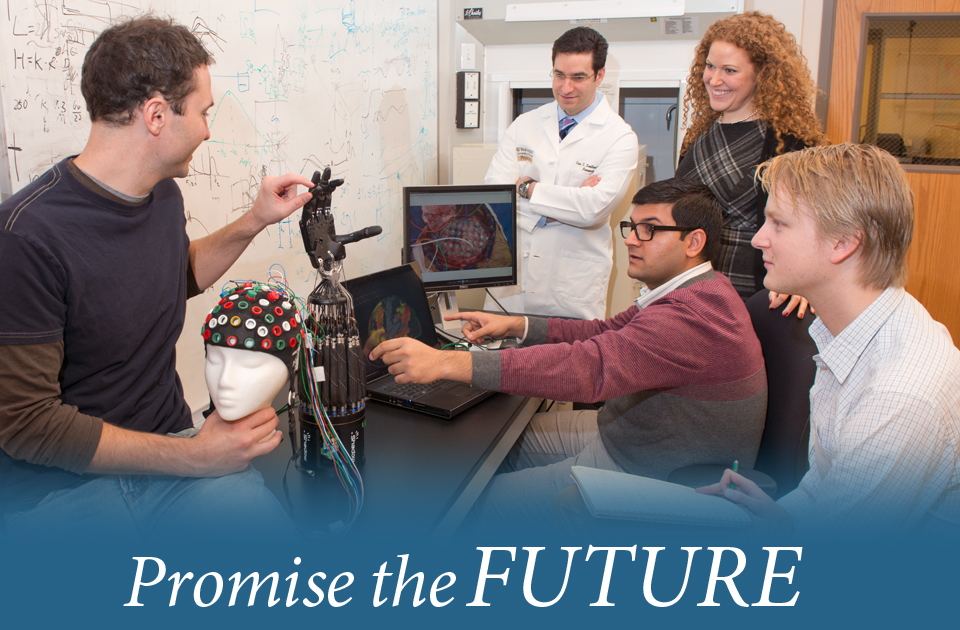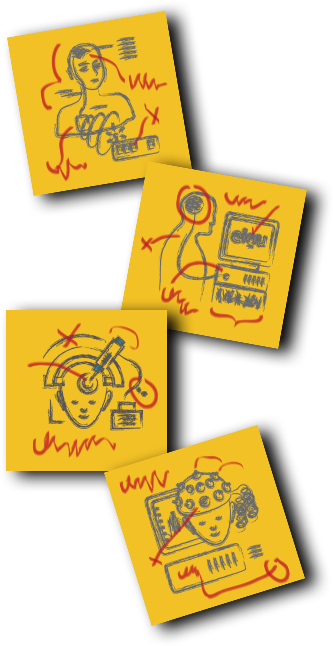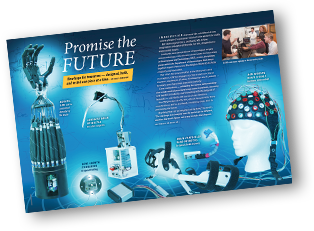
ABOVE: Eric C. Leuthardt, MD (white coat), leads an impromptu meeting of a CINT team.

BY HOLLY EDMISTON
IMAGINATION may seem like a childhood dream, a mere glimpse of a gossamer vision of some wished-for reality.
But neurosurgeon Eric C. Leuthardt, MD, defines imagination somewhat differently. For him, imagination is where reality begins.
Leuthardt, associate professor of neurological surgery and neurobiology, is the director of the Center for Innovation in Neuroscience and Technology (CINT), a cross-disciplinary group within the Department of Neurosurgery that brings together experts from across Washington University to foster creativity and innovation.
That effort has proved fruitful. In the three years since its inception, CINT has engaged 32 clinical and non-clinical inventors, resulting in 47 ideas, 16 fellowships and 12 patents — for which seven have been licensed to industry.
Cross-connections — validating the science, demonstrating that a new medical procedure brings value to patients, accessing new markets in industry, and resonating with the zeitgeist of humanity — are vital to the success of any invention.
The CINT provides an effective, ethical framework for these considerations. But for Leuthardt, everything circles back to envisioning the future.
“Anything that can be imagined can be done,” he asserts. “The challenge is to imagine how the world can be different, and then the world figures out a way to make that happen.”
The past 100 years has created an impressive track record of how imagining can lead to new realities, says Leuthardt, who also is an associate professor of biomedical engineering and of mechanical engineering and materials science.
From commonly used technologies such as instant messaging and Skype to more esoteric military applications such as Lockheed Martin’s HULC (human universal load carrier), imagination is the catalyst of invention.
At the CINT, Leuthardt and colleagues focus on creating new technology to serve neurosurgery. By formalizing relationships among the School of Medicine’s Department of Neurosurgery, the School of Engineering and the Office of Technology Management, collaborators at the center hope to foster creativity and streamline the process of scientific and technical innovation and real-world application.
Much of the work being done at the CINT is focused on technologies that can impact care of patients with neurologic disease. This ranges from the creation of specialized devices to the more fundamental fields of neuroprosthetics, motor physiology, speech physiology, epilepsy and stroke rehabilitation. The technologies that have emerged have encompassed a broad range, including implantable sensors to treat hydrocephalus, novel coatings of orthopedic hardware to facilitate bone growth, and engineering solutions for stroke.
CONTINUED BELOW
A gallery of prototypes from the Center for Innovation in Neuroscience and Technology
ROBOTIC ARM can be controlled directly by the brain
The idea of a brain-computer interface has been a flagship technology and scientific endeavor of the CINT. Indeed, many of the inventions developed or under consideration are related to issues of restoration, enabling people with spinal cord injuries or who have had a stroke to regain function.
“That’s where we begin, but it’s not where we end,” says Leuthardt. “As a physician, it’s critical to restore function to people with motor disabilities — that’s absolutely vital. But that is Chapter 1 of how we see ourselves, what we think our limitations are. Maybe our ability to interact with the world no longer stops with our fingertips and bodies, in a real way.”
Fundamentally, Leuthardt hopes to change how humans interact with machines. Although that might sound like science fiction, neuroprosthetics — devices linked to the brain that allow patients to move a robotic arm or a cursor on a screen simply by thinking about doing so — already exist. According to Leuthardt, this type of technology will one day be as commonplace as the video games of today.
Perilous valley
A “Death Valley” gap between public and private support for costly device research discourages inventors. CINT bridges this gap by working with investors to target worthy ideas — speeding the process, improving results and controlling costs.
“My job is to make it boring,” he says. “We may get excited about the new iPhone 5, but we don’t get excited by our DVD players anymore. Similarly, neuroprosthetics, body modulation and cognitive capability will one day no longer inspire awe at the magnitude of the technical accomplishment; they will just be a part of everyday life.”
Another key area of study at the CINT is brain mapping. Leuthardt and his colleagues are developing advanced techniques to locate and preserve critical areas of brain function.
During any neurological surgery, a key concern is not doing any harm to the brain while fixing a problem, such as operating on tumors or areas affected by epilepsy. Currently, neurosurgeons are able to watch the brain “light up” in real time during surgery as participants perform tasks such as talking or moving their hands. However, this process occurs during “awake” surgeries, something Leuthardt would like to change. New technology in development will allow neurosurgeons to assess critical brain areas — such as those devoted to speech and motor function — by monitoring the specific electrical signatures of various brain networks while the patient is anesthetized.
This type of breakthrough, which benefits patients by removing a risk for serious injury, is an example of the type of inventiveness the CINT hopes to foster. By providing an institutional structure that brings together people from diverse backgrounds — medicine, engineering, computer science, physics, chemistry, mathematics, nanotechnology, law and business — the CINT promotes collaboration, allowing innovation teams to generate ideas that none of the individuals would have been able to create by themselves.
CONTINUED BELOW

Never has there been such potential to improve human health through technological innovation. However, financing, regulations and the need for broad expertise makes innovation challenging. The Center for Innovation in Neuroscience and Technology (CINT) devises collaborative strategies for navigating the journey from an “Aha! moment” to a new medical technology.
“The world’s become a more complex place,” Leuthardt explains. “All of these fields have become very subspecialized.
The benefit is that it gives us expertise in that subspecialty, but it’s also a worldview that can stymie creativity.”
However, he says, if a neurosurgeon and an engineer sit down to talk, it’s likely the interaction will lead to non-linear, unexpected conclusions. A physician may learn about an existing technology — something that is very exciting to the engineer — that would solve a particular medical problem.
“Eric has been successful in creating a wonderful collaborative research environment within the Department of Neurosurgery,” says Ralph G. Dacey Jr., the Henry G. and Edith R. Schwartz Professor and head of neurological surgery. “The Center for Innovation in Neuroscience and Technology has facilitated the development of several break-through neuromedical technologies.”
Finally, Leuthardt emphasizes that the academic and medical cultures can be inhospitable to creativity in that they often do not allow for trial-and-error thinking. In the creative process, he asserts, it is acceptable, and perhaps even desirable, to make and learn from mistakes.
“Education and expertise can be limiting,” says Leuthardt. “We need to be humble about our knowledge so that we can learn from other people. Innovation, more than ever, comes out of good relationships with other people.”







